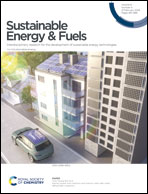Management of waste crustacean shells for the construction of a carbon-negative circulation model†
Abstract
Annually, billions of tons of food waste are disposed randomly, thereby severely wasting bioenergy. In this case, combining bioenergy with carbon capture and storage (BECCS) has become necessary carbon-negative technology to achieve the long-term carbon mitigation goal. Herein, waste crustacean shells (WCSs), which possess a natural alkaline metal compound/biopolymer composite multi-layered fiber-clustered structure, were employed as feedstock for BECCS based on the utilization of their pyrolysis products. The pyrolysis process of WCSs was analysed in detail, and the kinetic parameters (Ea and A), reaction mechanism, and thermodynamic parameters (ΔH, ΔG, and ΔS) were simulated and calculated for further comprehension of the pyrolysis process. Subsequently, optimal pyrolysis parameters were adopted to control pyrolysis products. The results of this study show that a considerable amount of CO2 could be directly fixed by a biochar composite (225.02 mg CO2 per g at 50 °C, 0.2 bar) and indirectly avoided by utilizing biogases/oils. This study can provide a reference for the disposal of other solid waste and promote the large-scale application of BECCS to meet climate change targets.

- This article is part of the themed collection: Sustainable Energy & Fuels Recent HOT Articles


 Please wait while we load your content...
Please wait while we load your content...